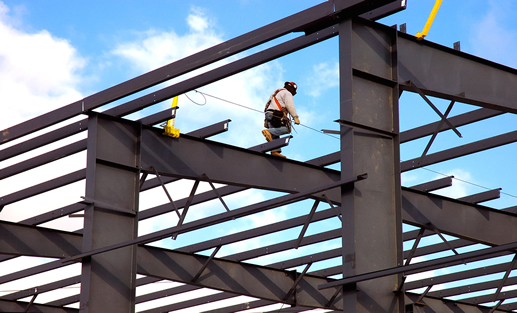Due to the importance of the role it plays in any large-scale building project, structural steel has little choice but to be large, bulky and rather heavy to say the least. According to the team at wesellrsj.co.uk, steel beams and RSJs often represent some of the most challenging supplies of all to move around building sites and ultimately set in place – a challenge that demands both skills and common sense on the part of the workforce present.
Of course, it pretty much goes without saying that shy of inviting a superhero to join the workforce, moving these kinds of supplies manually and without the help of heavy machinery just isn’t going to happen…not now, not ever. There will always be those who decide to give it a go, but the result is never anything more successful than torn muscles, broken bones and a lifetime of regret and embarrassment. Still, where there’s structural steel to be moved you can pretty much guarantee that there will indeed be the necessary equipment to move it – the key to getting it right therefore being to approach the machinery and the job with common sense.

Does a standard driving license and the ability to operate a hammer-drill mean you’re qualified to operate heavy plant machinery? Not even close – it’s like trying to fly a plane with a canoeing qualification. This is one of the first things to bear in mind as it’s these kinds of assumptions that lead to so many accidents being caused each day on construction sites due to nothing more than heavy items and heavy plant being approached with a careless attitude, or no thought whatsoever.
Here’s a look at just a few tips on the safer handling of structural steel on building sites:
Certification and Training
As mentioned, even if you think you’re the best driver on the face of the Earth and fancy yourself as a dab hand with a spanner, this sadly does not mean you’re in any way qualified to get busy with heavy lifting equipment. There’s a reason why certification and training courses exist for this type of equipment and why the UK’s leading names will only ever allow such machinery to be used by those with the necessary qualification – it can save lives. Mandatory they may not be, yet, but for the sake of getting the job done and getting it done safely, it’s really the only common sense way to go.
So, prior to diving into any such vehicle and ‘having a crack’ at getting the job done, ask yourself whether or not you’ve received the necessary training.
Competence and Confidence
Something else to be aware of regardless of the level you’re working at on the site in question is exactly how confident and competent the individuals charged with the heavy lifting jobs really are. The reason being that just because a person has the necessary qualification that says they can indeed handle the job doesn’t necessarily mean they’re confident enough to handle the more demanding jobs. After all, there’s a big difference between a newly-qualified rookie and a seasoned builder that’s been operating heavy plant for over 30 years – the latter clearly making the more sensible choice for the most demanding and important jobs of all.
Machinery Limits
Of course it doesn’t all come down to the workforce as it will in essence come down to whether or not the machinery itself is up to the job at hand. Every piece of plant machinery across the board is supplied with a series of crucially important and very specific guidelines when it comes to what it can and cannot do – guidelines that are penned for a reason. There isn’t a single piece of plant machinery that can do everything across the board and has no specified limits – to ignore such limits is to place life and limb at risk.
If, for example, a heavy lifter’s guidelines say not to load more than 1,500kg of materials onto it at any one time, this does not mean you’ll get away with 1,575kg. It could be the proverbial straw that breaks the camel’s back…while destroying your construction project at the same time.
In a Nutshell
All in all, it’s a simple case of common sense and following the universal building site rule that every job has its ideally suited tool – so why take risks using anything else? About 95% of all building site accidents and injuries in the UK each year could be easily avoided if it were only that simple tips like those listed here were followed universally and comprehensively.

